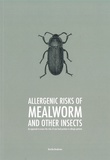Allergenic risks of mealworm and other insects
An approach to assess the risks of new food proteins in allergic patients

Broekman, Henrike
- Promoter:
- Prof.dr. A.C. (André) Knulst & prof.dr. C.A.F (Carla) Bruijnzeel - Koomen
- Co-promoter:
- Dr. G.F. (Geert) Houben & dr. K.C.M. (Kitty) Verhoeckx
- Research group:
- Knulst
- Date:
- May 23, 2017
- Time:
- 14:30 h
Summary
Assessment of cross-reactivity and primary sensitization and allergy by new food proteins: the goal and contents of this thesis. Allergies to new food proteins can result from cross-reactivity in existing sensitized or allergic individuals and thereby thus immediately manifest themselves in elicitation of allergic reactions upon consumption (elicitation phase). However, allergies to new food proteins may also result from de novo sensitization of - and development of new allergies in - susceptible individuals, in this case thus first requiring these individuals to become sensitized (sensitization phase) before subsequent exposure or intake may elicit allergic reactions (elicitation phase). The aim of this thesis was to develop and test a structured approach to assess the cross-reactive and de novo allergenicity of potential new food proteins, and examine the allergenic risks of insects as potential new food protein sources as a case study for the structured approach, with specific focus on mealworm as one of the candidate insects as new food protein source. There is no substantial history of use of insects in food in Europe. However, in some other regions of the world, consumption of insects is more common. Reports of food allergy to insects are known, mostly from Asia, where insects are high on the list of causing anaphylactic symptoms. Detailed descriptions and assessment of the relevance with respect to a possible introduction of insects as a new food protein source in Europe were not available prior to the start of our study. In Chapter 2, the background and proposed structured approach for allergenicity assessment of new food proteins and protein sources is presented and studies on mealworm and other insects are presented and discussed in the following chapters. Both in cross-reactive allergy, such as apple allergy in pollen-related-food allergy, and primary allergy, such as generally is the case for peanut, changes in allergenicity caused by heating have been described. Different forms of processing therefore need to be considered in allergenicity assessment. In Chapter 3, this is illustrated for the case for mealworm. Chapters 4 and 5 address risks of cross-reactivity of mealworm proteins in patients with allergies to phylogenetically related allergenic sources (shrimp and house dust mite) and risks of sensitization in patients with unrelated allergies. Primary sensitization and allergy caused by mealworm exposure is described in Chapter 6. In Chapter 7 it is addressed whether and to what extend risks identified for mealworm may also apply to other insects that may candidate as new food protein source, with emphasis on two identified at-risk populations: shrimp and primary mealworm allergic individuals. The results of this thesis are summarized and discussed in the final chapter, in light of the risks of insect proteins for different risk groups in the general population.